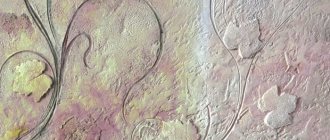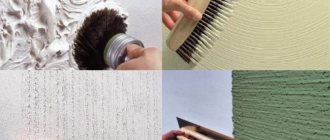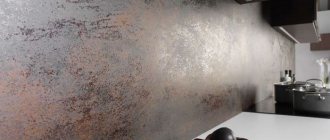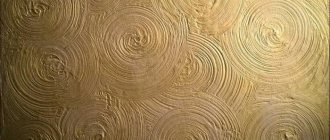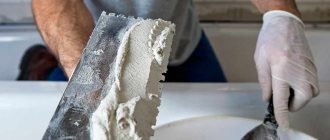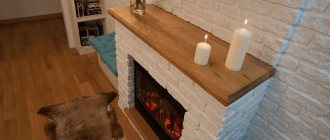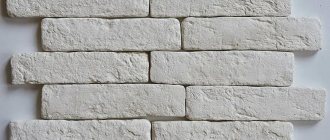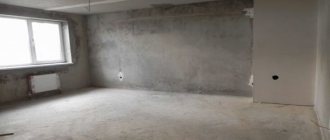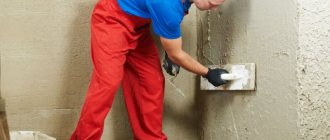What is textured plaster and what is it used for?
Textured plaster is a special type of finishing coating that creates a decorative relief on the surface of the walls. The depth of the relief of such finishing varies from 1 to 5-7 mm. It is created thanks to fillers of various sizes and shapes included in the plaster, as well as special application techniques.
Currently, textured finishes have gained immense popularity as a finishing coating for walls. It is popular not only for interior work, but also for exterior plastering of facades.
The material differs in structure, composition and color, which means it allows you to choose the most appropriate option for a textured pattern in each specific case.
The textured mixture helps create a unique interior without requiring any special effort. It is easy to work with the solution yourself; in most cases there is no need to involve professional workers.
Textured plaster is widely used for interior decoration
What is the cost of applying textured plaster?
Correctly and efficiently done wall decoration is the main component of a good and good repair. But, it is necessary to remember that only a master knows all the features and subtleties when working with decorative plaster mixtures.
Accordingly, to avoid mistakes, it is recommended to contact only proven and professional specialists who have all the required skills and knowledge.
The cost of coverage per m2 depends on the following factors:
- The type of base (prepared surface) on which the mixture will be applied;
- Type of plaster;
- Application technologies.
At the moment, the price of materials per 1 m2 is about $8-9. All work with textured plaster costs from 5 to 13 $/m2. In the version with “Venetian” - 12-21 $/m2.
Covering walls with this plaster is a labor-intensive and responsible process that necessarily requires special skills and knowledge. To obtain a high-quality and durable coating, you need to choose the right material for finishing, prepare the surface and professionally plaster the walls, while observing the rules, regulations and recommendations.
Advantages and disadvantages
Let's consider the positive qualities of the finishing material:
- textured coating looks good and contributes to better interior design;
- the surface relief can be designed in different styles, creating beautiful patterns by choosing a special technique for moving the tool;
- the material is durable, the surface retains its original appearance for a very long time;
- the mixtures are resistant to ultraviolet radiation, so they do not gradually fade in the sun, maintaining their original attractiveness;
- the finishing coating improves the thermal insulation qualities of the base;
- mixtures for interior decoration do not contain aggressive chemical components, therefore they are considered environmentally friendly for people;
- The color of the finish can be changed as desired by adding dyes to the solution.
On a note!
The finished mixture can be supplemented with other components to create original visual effects.
The disadvantages include:
- the coating does not withstand strong impacts, gets scratched, chips;
- a textured surface is more difficult to clean from dust;
- for high-quality materials you will have to pay an impressive amount;
- in order for the surface to look holistic, the mixture is applied without delay or interruption;
- surface defects are very difficult to correct.
If the application technology is violated, cracks may appear on the surface. The material often peels off and swells. Therefore, you need to choose a mixture suitable for the specific type of base and follow the manufacturers’ recommendations when performing finishing work.
Types of textured plaster
Finishing walls with textured plaster allows you to achieve different visual effects. The desired pattern or pattern can be achieved using additional components or filler in the texture mixture. The method of application also plays a significant role. Next, let's talk about the most popular effects of textured plaster (types of textures).
The market range of textured plaster is quite wide
Bark beetle
Rolling solution is also known as "Bark Beetle". The appearance of the coating resembles “eaten wood”. The solution contains marble chips measuring 0.1 - 4 mm. A pattern with a uniform texture is made with a plastic grater, grinding the surface with chaotic movements. Thanks to the grater, the marble grains roll, leaving grooves behind them, and the semblance of woodworm “passages” are formed.
To achieve this effect, a material thickness of 3-7 mm is required. It is used for finishing both outside and indoors.
You can get other patterns from the roller mixture by changing the direction of grouting: the “Lamb” pattern (circular movements with a grater), “Rain” (vertical movements), “Carpet” (horizontal movements).
Bark beetle plaster is riddled with numerous passages
What types of effects are there?
Concrete.
Clavel Loft-Beton concrete-effect decorative plaster is used in modern loft and minimalist style interiors.
Today this style is considered the most popular and in demand for modern interiors. It is worth noting that any wall requires additional protection of its own surface in the form of finishing. Clavel Loft-Beton decorative plaster for concrete can help in this matter. It looks very stylish, can withstand high operating loads, can be subjected to wet cleaning, and, unlike a regular concrete surface, retains heat perfectly.
Travertine.
Wall finishing is a combination of Travertino Naturale Fino (travertine effect) and Veneto (marble effect) plasters.
You can create an imitation of one of the most popular materials using plaster with imitation travertine. The final work will not have any differences with natural coating. It should be taken into account that the cost of such plaster is quite high, but its appearance and practical properties fully pay for it.
Tree.
Textured plaster Clavel Strutura using wood-look technique.
Wood-look plaster is used in cases where it is necessary to create a cozy atmosphere of the natural environment using modern materials. It has a long service life and extremely accurate imitation of natural wood.
Textile.
Decorative coating Clavel Aura with imitation of smooth silk.
Textured plaster to resemble “fabric” - allows you to decorate a room in an oriental/classic style at minimal cost. Its peculiarity can be considered resistance to abrasion, resistance to sunlight, is not subject to cracking, is easily restored and has a long service life. The most popular imitation suede or silk.
Bark beetle
Clavel Rustica acrylic bark beetle plaster provides facades with protection for 30 years without color fading.
One of the main components in the mixture are special granules. When force is applied to them, they form various grooves and grooves. The pattern can be horizontal, vertical, diagonal or generally chaotic. Such facades have a long service life and, due to the high elasticity of the composition, do not crack.
Crack effect.
Textured plaster Clavel Mystique creates the effect of cracks without reducing the strength of the wall.
Otherwise, this effect is called craquelure, which has recently become quite popular. Upon completion of all work and drying, the surface itself cracks with the most amazing patterns. There are coating options with the use of a special activator for cracking, as well as without it.
Natural stone.
Clavel Riviera textured plaster is designed to create the effect of natural stone or rock.
The plaster completely imitates the texture of natural stone - chips, veins, layers, variations in shades, etc. By additionally painting the surface, you can obtain a perfect resemblance to natural stone. Ideal for decorating a bedroom, living room or hallway.
Imitation leather.
Decorative plaster Clavel Mystique reproduces the effect of leather.
Recently, it has been very often used for decorating residential premises. Plaster can be combined with all kinds of materials and introduced into existing styles. Wood and stone, steel, and glass will perfectly complement this coating. Looks great on columns and niches.
Masonry.
All-natural lime decorative plaster Clavel Travertino Naturale to create the effect of classic Roman masonry.
Creating such a finish involves manually cutting rustications on a semi-dried finish or using a shaped roller. Particularly suitable for interiors in antique style, as well as classical and neoclassical style, giving the room completeness and aristocratic restraint.
Classification by type of base
Depending on the type of base included in the composition of textured plaster, the following varieties are distinguished.
Mineral
The composition of such plaster includes a cement mixture, as well as additives that increase the plasticity of the composition. Mineral plaster is most often applied to an already prepared surface coated with a quartz primer. The mixture is white, but thanks to pigments it can have any shade. Produced by Ceresit, Kreisel, Bolars, Vetonit.
Silicate
Made of silicate glass. A feature of silicate plaster is its rapid hardening and the need to quickly create the desired pattern. Silicate plaster has high vapor permeability and resistance to external influences. That is why it is most often used for facade work. Produced by Ceresit, Caparol.
Painting plastered walls
For the convenience of applying paint, use a special tray for the roller; it helps to better roll the paint into the roller, which means there will be no drips on the wall. Next, we paint the surface with water-based paint in a pre-selected color.
It is best to paint the entire surface at once so that the tone is the same everywhere; the remaining layers are selected as planned, depending on the chosen pattern.
Masters use small brushes to paint walls; with them they can create a whole picture, a so-called panel, but for now this task is not for us, although if you are confident in your artistic abilities, you can try. After the entire surface has dried, it can be varnished with a solution for interior work.
Classification according to other parameters
There are a large number of types of textured plaster. The special components included in the composition allow you to create different visual effects. For ease of use, the plaster is sold ready-made or as a dry mixture. Decorative finishing of surfaces is carried out under various conditions. Therefore, the requirements for plaster mixtures are also changing.
According to delivery form
The material is sold as a ready-made mixture in buckets or in paper bags with a powdery substance. Dry solutions are mixed with water and dyes. The average weight of the bags is 25-30 kg.
Ready-mixes are often colored during production and do not require the addition of any components before finishing. The solution is applied to the base without difficulty, since the number of components in it is perfectly balanced.
It is better to use the finished material when finishing small areas, but the limited choice of colors often forces you to choose a dry mixture.
By application
The composition of plaster mixtures differs because interior finishing requires skillful execution. Necessary properties for indoor work:
- ease of application;
- good decorative properties;
- vapor permeability;
- ease of cleaning.
The bathroom walls and ceiling should have a waterproof coating. In the bedroom and living room, the plaster should allow oxygen to pass through well. The covering of kitchen walls should not absorb odors. Staircase openings require the strongest cladding that can withstand impacts.
According to operating conditions
Textured mixtures are used for interior and exterior decoration of buildings. The requirements for building mixtures differ in different places. Therefore, decorative plasters are divided into:
- façade;
- materials for interior work;
- universal.
The mixtures differ in composition. To create facade finishing, toxic or less safe components are used. The special composition increases the resistance of the coating to external influences. The finishing coating is used in extreme conditions.
Mixtures for interior decoration are often more expensive, since substances that are harmless to humans are added to them to maintain good performance. These components are more difficult to manufacture and therefore cost more.
Manufacturers offer all textured mixtures in the form of a ready-made solution or powder
By gloss level
There are different types of textured mixture for walls, depending on the degree of gloss:
- Matte. The color of the coating does not change tone depending on the direction of view; the surface will be the same from any angle.
- Glossy. The coating of such plaster “shimmers” in the light. As a rule, reflections of a glossy surface affect the perception of tone, which must be taken into account when selecting a color tone.
- Intermediate. This textured plaster has average gloss values between matte and glossy plaster. The effect of tone depending on angle is less pronounced.
Important!
When tinting glossy plaster, professionals recommend choosing a color several shades lighter, because... The glossy finish makes the color darker.
Varieties
With the development of science, new finishing materials have appeared. Modern plaster compositions used to form a relief surface differ in several parameters. They are mainly divided according to properties determined by binders, additives, and fillers.
By appearance and resulting effects
The decorative plaster mixtures produced allow you to use simple techniques to create coatings with the effects of fur coat, rain, bark beetle, roller plaster, etc.
Popular textures with the effect:
- antique stone;
- sandy bottom;
- tree bark;
- brickwork;
- stone cladding;
- reptile skin;
- rough or fleecy fabric;
- geometric patterns.
To achieve greater expressiveness, pearlescent or metal components are introduced into plaster mixtures as fillers.
By application
Compositions for creating decorative textures are divided into:
- facade plasters;
- universal;
- plasters for interior decoration.
Finishing materials that are used to decorate facades are used in extreme conditions. Therefore, technologists have developed special compounds that can withstand the aggressive influences of the street environment: rainfall, hail, heat and ultraviolet rays of the sun, freezing, harmful substances in a polluted atmosphere.
But sometimes façade textured mixtures are also used indoors!!!
The conditions in the premises are not so harsh - they do not require decorative plaster for interior wall decoration to have the same durability, but have other requirements. Here, the maximum flexibility of the plaster material is required to perform fine skillful processing (workability), increased decorativeness, environmental friendliness, vapor permeability, and ability to be cleaned. In addition, textured plaster in the interior of functional rooms is subject to additional requirements. In bathrooms, for example, the plaster of walls and ceilings should be waterproof, in the interior of the living room and bedrooms it should be freely “breathable”, in the kitchen it should not absorb kitchen odors, and on landings it should be resistant to mechanical influences.
By filler size
The basic mineral fillers for plaster mortars are stone flour and crumbs, quartz sand, clays.
Based on the size of filler particles, plaster mixtures are divided into:
- coarse-grained (granules 3-5mm);
- medium-grained (grain 1.5-2.5mm);
- fine-grained (fraction 0.5-1mm);
- fine-grained (flour up to 0.5mm).
Medium- and coarse-grained plaster mortars are usually used for external finishing (facades, gazebos, fences). An example of a coarse-grained plaster mixture is marble plaster. Other types are for interior decorative work.
Mineral
Binders such as gypsum, clay and lime paste have been known since pre-Roman times. Cement was also used in antiquity, however, modern cements are an artificial product. These materials belong to the mineral class, which is why plaster mixtures based on them are called mineral.
Mineral plaster is different:
- environmental friendliness;
- air and vapor permeability;
- increased strength;
- non-flammability;
- water-repellent ability;
- high adhesion to any surfaces;
- increased sound insulation;
- resistance to biodamaging factors;
- frost resistance;
- ability to retain heat;
- low price (cheaper than other mixtures).
Mineral solutions without adding color are gray, brownish (from clay) or white.
The mixtures are easily tinted, but when dry they turn pale.
Seal with water. During storage, dry mixtures must be protected from moisture. They come to the market in the form of dry mixtures. Packaging: paper bags. Quantity – up to 25 kg.
Silicate
The species is classified as mineral. However, silicate mixtures are placed in a separate class due to the characteristics of the binder - liquid glass. It is used only for external work, as harmful substances are released during application.
Perfectly performs the functions of relief decorative plaster in outdoor conditions:
- non-flammable;
- easy to clean;
- adheres well to mineral wool and polystyrene foam insulation;
- best for finishing cellular concrete and shell rock.
The main disadvantages are that they harden too quickly. The underlying coatings (primer layer), as well as the overlying ones (paints) should be on a silicate basis. Low elastic. You can buy ready-made or dry mixture.
Silicone
The most expensive of the plasters, but superior to others in most parameters:
- durable (the old coating is removed only by cutting it out);
- elastic;
- universal;
- durable.
The binder is silicone resin.
Acrylic
Compositions based on acrylic resins are highly elastic and durable. They are waterproof and therefore suitable for bathrooms, but not suitable for bedrooms. They are inferior to mineral compositions in terms of resistance to UV rays. Easy to take injected additives, easy to color, easy to use. The resin content makes them flammable, so fire retardants are added to the mixture. More expensive than mineral ones, but cheaper than silicone ones.
Acrylic compositions require a good primer, since water-soluble mixtures are easily dehydrated when water is absorbed by the porous base. Sold ready-made. They have a short lifespan, so you need to work with them without interruptions.
Color range of textured plasters
More often, paints that imitate natural materials and wood textures of different shades are used. White is used in office spaces or public reception areas. This type of finish can be used in small bedrooms.
A room with white walls will appear brighter, cleaner and fresher. This color serves as the basis for a variety of color additions.
On a note!
Gray shades are suitable for modern style, for finishing under concrete. Pearlescent colors give each room an oriental flavor.
Plaster consumption
The thickness of the layer and the features of the textured pattern determine the consumption of the plaster mixture per 1 square meter. m. Packages of plaster indicate the average weight consumed per 1 square meter. m.
What is the cost:
- The bark beetle is applied in a layer of 2 mm, so per 1 sq. m. you will have to spend 2.7-3 kg. This means that 1 bucket of 25 kg covers 8.5-9 square meters. m.
- Relief treatment with a 3 mm layer of gypsum mixture will require 2.5-3 kg per 1 square meter. m.
- The cement mixture for textured finishing consumes 5-5.5 kg per 1 square meter. m. with a thickness of 3 mm.
Important!
For the most accurate calculation of consumption, you need to lay the plaster on the wall in an even layer. During the work process, it is more convenient to make calculations in the number of buckets per 1 square meter. m.
Before buying a tool for decorative plaster, you need to decide on its type
Plaster "bark beetle"
The most popular today is textured plaster with the interesting name “bark beetle”. The surface of it looks as if it had been worn away by beetles of the same name. Let's see how to properly apply it to walls.
This plaster is sold dry. It contains a fairly large abrasive, with the help of which the famous effect is achieved. We start by diluting the mixture according to the instructions on the package. We cover the floors so as not to stain them. We arm ourselves with a spatula and an American iron (trowel).
Table 5. Creation of the “bark beetle” texture.
| Steps, photo | Description |
| We smear the plaster on the wall, stretching it strictly from bottom to top. You need to apply it to the skin. The part of the mixture that remains on the malka is removed and thrown into the trash bin, since there are no more stones in it. We pass the entire wall like this. |
| As soon as the plaster begins to dry, we arm ourselves with a plastic spatula and begin to carefully stretch the surface from top to bottom. Following the tool, pebbles will begin to stretch, from which characteristic traces will remain. Make sure that the spatula does not stick to the surface and clean it constantly. |
Prices for popular types of putty
Putties
So, today we have discussed with you 4 ways to create a beautiful relief surface from plaster and putty. Visually, all options look different, so many will find the method that is most attractive to them and use it in their repairs. We hope it was interesting with us.
Today, imitation brick has become a real trend when decorating modern interiors in a utilitarian style. Also, a similar solution is used in combination with other designs - here a lot depends on the type of imitation itself and the resulting surface color. In a special article we will tell you what imitation brick can be like for interior decoration, and we will also look at several ways to create it.
How to make textured plaster yourself
You can make textured plaster for walls with your own hands. Materials available in the market are used to make a suitable mixture.
With PVA glue
Regular putty is mixed with PVA or wood glue or drywall putty.
With primer
The main component is a fine-grained white mixture. A primer is added to it in a ratio of 6:2. The consistency of the mixture should resemble thick sour cream. Color pigment is added to create a tint.
With plaster
Gypsum plaster is mixed with wood glue or PVA and left for 5-10 minutes. Then it is mixed again and applied to the wall.
With baby
If you add marble chips to the putty, you can imitate natural stone. You need to stir the ingredients with water until the mixture becomes thick, like sour cream. Color pigments are not added to the solution, so the plaster can be painted only after it has dried.
How to make a textured surface
If you decide to make a drawing yourself, then you need to know some rules. If the surface is variegated, then each individual coloring composition must be prepared immediately before its use, and not in advance. The layers are laid alternately after the previous one has dried.
After drying, the paint loses its tone and becomes lighter; this must be taken into account when choosing a color.
Ways to create a relief pattern on the wall
To form a pattern, you can walk over the still damp plaster with a figured roller or a simple sponge. In addition, in construction stores you can buy special spatulas with grooves and other relief patterns.
You should know! Before use, the instrument must be thoroughly cleaned to prevent unevenness.
To summarize, we can say that doing relief plaster with your own hands is not such a difficult task. It is only important to prepare the solution correctly and do everything exactly in accordance with the above instructions.
How to apply textured plaster
There are many ways to apply textured plaster. To create an original relief, various tools are used, and special techniques for applying the mixture are mastered. The textured surface is created by imprinting, brush strokes, trimming, and various stencils. A relief on the wall can be created using the modeling technique.
Roller
Let's figure out how to apply textured plaster with a roller. You can use different types of this tool:
- rubber embossed with patterns that leave imprints on fresh plaster;
- rollers for loosening the mixture on the wall and creating a fur coat effect.
Note!
The roller can be rolled over fresh plaster 10-15 minutes after application. To prevent excess mixture from sticking to the roller, you need to moisten it with water.
Stamps, stencils
To imitate wood texture or masonry, stencils or stamps made of elastic and rigid materials are used. The surface of the tool is moistened before contact with fresh plaster. The stamp is pressed into the surface so that a print remains on the wall without defects.
Stencils are used differently. You can use them to create three-dimensional patterns or designs, the thickness of which does not extend beyond the boundaries of the general layer. The stencil is attached to the wall, then decorative plaster is applied on top. The surface is visually modified with other tools and materials. Then the stencil is carefully removed. Such tools allow you to create patterns on the wall from plasters of different colors.
Trowel
The trowel allows you to give the surface a varied texture and smooth out sharp ridges left after the roller. You can move along the surface only with the corners or the entire plane of the trowel horizontally, vertically, or make circular movements. It all depends on what exactly the pattern should be.
Venetian style - two-color application technique
The technology for applying Venetian plaster only seems complicated.
Let's look at a simple instruction:
- plaster the wall, prime it;
- After complete drying, apply a thin layer of tint;
- after 6-8 hours, prepare a light and dark mixture;
- the components are applied to the trowel, then arc-shaped strokes are made on the wall;
- the first strokes should be at a distance, then you need to close the empty area between them;
- then you can mix 2 different colors with a trowel and fill all the empty spaces with the mixture to completely cover the wall and imitate a marble surface;
- after the plaster has dried, the surface is rubbed with a spatula or sandpaper, and protruding pieces of the mixture are removed;
The surface is then varnished or waxed.
The stencil allows you to create complex patterns even without experience
Versailles reception
First, the wall is treated with a quartz-primer mixture several times. Then the model composition with a thickness of 2-3 mm is applied with a trowel. The mixture is worked with a plastic trowel to create an arched pattern. You need to make short passes with the tool, constantly changing the direction of its movement.
The trowel is lightly pressed against the surface and pulled upward in an arched manner. The result should be sinuous indentations. Wall cladding in the Versailles style is made from ordinary putty.
If the layer is too thick, you need to wait until it dries completely. This often takes several days. After drying, sharp protrusions and protruding mixture are removed. The surface is dust-free and primed. Then the coating is painted with a mixture of tinted primer and silver. For this work, a hard foam roller is used. In this case, the color of the recesses does not change. Then the entire surface is covered with a mixture of varnish, glitter and plain water.
Using improvised means
The textured surface is created using various available means:
- chopped fragments of foam rubber;
- pieces of fabric gathered together;
- crumpled polyethylene;
- cutlery;
- combs.
An original pattern can be created with any object. The main task is to show imagination.
Types and composition of decorative plaster
Decorative plaster is completely safe for human health and the environment; its composition is usually based on one of such components as cement, acrylic or silicone. It is by the main ingredient that the material is classified, since the properties of the final product directly depend on it.
It is also important to use each type of plaster for its intended purpose and not otherwise.
- If we are talking about exterior finishing, then only facade plaster is used for such work - it is more resistant to temperature changes, atmospheric conditions and ultraviolet radiation.
- Interior decoration is the element of interior types of plasters.
When choosing one or another type of material, take into account the features of its operation. Whether the room has high humidity or is not heated - this determines what type of plaster is best to use. The type of design is also important - what the final result of the finishing should be, what types of relief, patterns and degree of roughness are provided for in the interior style. Let's consider the possible options.
Mineral plaster
It is made on a cement base and may also contain lime, sandstone, clay and similar components. Due to its composition, this type of plaster has affordable prices and a wide range.
It is sold as a dry mixture, which has a number of advantages:
- Possibility of long-term storage at any temperature conditions. The dry mixture can be stored in unheated warehouses; it does not deteriorate at low or high temperatures. The main requirement is a dry room.
- You can prepare any amount of plaster needed for the current work. This is especially convenient for finishing large areas when work lasts several days.
- When preparing the working solution yourself, it is easy to vary its consistency. This may depend on the type of finish; for a smooth coating or roller work, you need a more liquid plaster, and for a three-dimensional design, a thicker plaster.
Mineral plaster is not fussy to work with; it is convenient to apply it with a spatula or trowel, and if the area is large, then using a hardware method. The thickness of the layer can vary depending on the need; when applying a layer of more than 15-18 centimeters, be sure to reinforce the plaster with mesh. After drying, this plaster forms a durable porous coating.
This finish is not prone to ignition and is ideal for soundproofing a room. It should also be noted that mineral coating can insulate walls well.
Of course, the appearance of mineral plaster is not particularly presentable, which makes its subsequent processing – painting, varnishing – mandatory.
Also, the paint layer is necessary to prevent vapors and moisture from entering the coating, which is porous in structure. With high humidity, fungus can form in them.
Acrylic plaster
It has a base of acrylic resin, which provides a durable layer of the finished material. Acrylic plaster has high vapor and moisture resistance characteristics, is resistant to ultraviolet radiation, various contaminants and temperature fluctuations. Due to its excellent characteristics, it can be used in rooms with high humidity, for example, a bathroom or kitchen, as well as facade finishing for outdoor use.
This type of plaster is sold in a ready-to-use form - you do not need to prepare it yourself, bring out the required thickness and mix thoroughly, avoiding the formation of lumps. You can add the desired dye to the finished acrylic plaster yourself or order the desired shade in a tinting studio, where it can be matched to the overall style of the interior.
It is important to prepare at once the entire volume of colored plaster required for work, otherwise it will not be possible to avoid different colors. Various additives, antifungals, antiseptics and the like can also be used. At the same time, the pricing policy is quite democratic; it is, of course, more expensive than mineral plaster, but much cheaper than other types of decorative plaster.
Acrylic plaster is probably the most convenient of all decorative plasters. Due to its composition, it has high plastic properties and is well suited for design of varying degrees of complexity.
First, the surface to be finished must be cleaned and primed - this way the layer of plaster will hold firmly and last for a long time. Acrylic plaster is applied with various spatulas; decorative elements can be made using rollers, brushes, various molds, or even the most original, homemade inventions.
It should also be noted the elasticity of this material. This fact allows it to be used for a wide variety of surfaces. Acrylic plaster is easily applied to wood, brick, OSB panels, porous materials, stone, drywall or even foam. It can be applied manually and mechanically. Special installations for application are used, as a rule, for large volumes of work.
It should be noted that acrylic plaster hardens quickly, so you need to work with it carefully. To get the same shade and texture of the coating, you should not take breaks in work for more than half an hour. During application, the material should be stirred as often as possible, especially after adding a new portion, so that it remains homogeneous.
Acrylic plaster finishes are impressive and quite durable. With this material you can fulfill any design fantasy and make your wildest dreams come true. Durability ensures ease and ease of maintenance. This coating can be washed with non-abrasive detergents and cleaned from dust and other contaminants.
Silicone plaster
Consists of silicone resins and various types of fillers such as fabric, mineral materials and the like. This type of plaster is purely decorative and is used only for finishing. It can be used both indoors and outdoors.
This type of plaster does not require preliminary leveling of the walls, as it will do it on its own, while simultaneously adding a decorative component. This material is more expensive than previous types, but its price is largely due to its universal properties, and therefore is completely justified. Silicone plaster is sold in containers of various sizes, which makes it possible to purchase it in the required quantity, even if it is small.
The advantages of this type of plaster are difficult to exaggerate:
- Very long service life. Even facade silicone plaster, subject to temperature changes, atmospheric conditions and direct exposure to sunlight, can retain its appearance for up to twenty years! What can we say about the interior decoration - the duration of operation here is even longer.
- High level of vapor permeability. This material can provide any necessary indoor microclimate. It easily tolerates moisture, high temperature or steam, condensation and mold do not form on the walls, and fungus is not dangerous.
- This material has increased elasticity , which means that the treated surface will not change even with mechanical damage.
Silicone plaster is sold white or colored - you can choose a ready-made shade, or you can color it as you wish. Can be applied as a smooth coating or using any decorating technique.
The technique of use is practically no different from other plaster mixtures.
It is important, after opening the container, to thoroughly mix the material, and also, before starting work, to thoroughly clean the walls from dirt, remnants of old plaster and the like.
For finishing, a metal spatula is used, which must be held at an angle to the surface being treated. The standing thickness depends on the size of the silicone plaster fraction, but in general, all these coatings are thin-layer. She is not picky in her work, and is quite suitable even for beginners, especially if you want to get an unusual and stylish design.
Silicate plaster
It is produced on the basis of liquid glass and also contains mineral additives and pigments. It is most often used as facade decoration, but can also be used indoors.
It copes well with protecting treated surfaces from the effects of atmospheric phenomena: dampness, wind, temperature. Available for sale in ready-to-use form, there is both white and colored plaster.
A distinctive feature of silicate plaster is its vapor and moisture resistance. These properties make it ideal for loose and porous walls, for example, aerated or foam concrete. The material allows for a breathable wall covering, which makes it unlikely that mold or condensation will form on the walls. The plaster is also resistant to cracking and has proven itself to be excellent in maintenance - it can be washed with water and is easily cleaned of dirt.
There are, however, some disadvantages of silicate plaster:
- The material fits well on mineral surfaces, but if you plan to work on others, careful pre-treatment is required. This increases the duration of the finishing process and the costs of its implementation.
- It hardens quickly, which means it needs to be applied at an accelerated pace, rework is excluded.
- May change color when exposed to sunlight, especially for bright and dark shades.
- It has a fairly high cost.
When choosing this type of plaster, you need to weigh its advantages and disadvantages; in certain cases, this type of finishing is ideal and outperforms other decorative coatings.
Decoration
After drying, the finished surface is covered with wax, varnish or paint. These materials give the plaster strength. The treated surface is easier to care for. For decorative plaster, special varnish and paint are used. Their components are compatible with the materials from which the mixture is made. To reduce varnish consumption, you can pre-prime the wall.
One of the original types of ceiling finishing is decorative plaster.
Painting plastered relief walls
A textured surface makes painting more difficult; a textured wall requires more finishing coat. When applying, you need to ensure that the paint gets into even the smallest crack. For this, in addition to a roller, you can use thin brushes, sponges or a spray. To prevent drips from appearing, excess paint must be smeared. The 2nd layer is applied to visually separate the convex parts of the surface.
Advice!
The paint can be tinted before use. Experts recommend adding a little black to the color to make the painted surface look natural and less irritating to the eyes.
Bas-reliefs
The surface is decorated with bas-reliefs using the method of self-sculpting or fixing ready-made plaster products. For manual work we use:
- spatulas;
- rollers;
- chisels;
- various tools for woodworking.
Fine-grained plaster or gypsum mixtures are used to make bas-reliefs. They are quite elastic, retain their shape and are easy to sand. Before applying bas-reliefs, the base cannot be pre-primed or varnished, so as not to deteriorate the connection with the surface. For modeling, you can use special templates. With their help, it is easier to leave patterns on horizontal and vertical stripes.
Types of decorative plaster finishing
Decorative plasters can be not only of different types, but also with various special fillers that will give the surface a particular effect. That is, there is no need to independently develop the decor and do it manually. Thanks to the special texture of the plaster, you can decorate the interior simply by applying it to the walls. These types of plaster include:
Textured plaster
The filler used here is mica, small pebbles or sand, and wood fiber. This is one of the most versatile and therefore common types of finishes. The layer thickness ranges from 0.2 to 2 mm. This type of plaster is the easiest way to implement various design ideas and textures; after application, you can play with it colorfully by painting it in different shades or highlighting elements with gold and silver pigments.
Structural plaster
Here, small quartz grains, sand or other minerals are used as additives. After application to the surface, this plaster gives a uniform layer of a certain pattern. Additionally, you can use a textured roller.
Venetian plaster
The main component of this type of plaster is the marble fraction, very finely ground. Therefore, all images made using this technique turn out smooth and shiny, visually similar to noble marble stone.
No less popular is a variety of Venetian plaster – Moroccan. It is made with the same materials, however, its peculiarity is the multi-layer coating; it is applied in three layers: the first and last of which are plain, and the middle one is gold-plated. Externally it also resembles marble slabs.
Flock plaster
Interesting, modern material. It consists of colored acrylic flakes, sometimes called flocks or chips. Particles can come in a wide variety of shapes and sizes. This plaster perfectly imitates suede, velor, leather and is successfully used to decorate various surfaces - ceilings, walls, columns.
Among all types of decorative plaster, I would like to note the most popular types of finishes - “bark beetle”, “lamb” and “fur coat”. Their constant demand among buyers is thoroughly justified: the textures of the plaster have an impressive appearance, are easy to use and practical to maintain. Of course, affordable cost is also an important factor. Let's look at each type in a little more detail.
Plaster Bark beetle
This mixture consists of several components; the bulk of the plaster contains special mineral granules, about 2 mm in size. Larger granules can also be used for outdoor work - they are more relevant for large areas. It is these particles that, when applied to the surface, create a peculiar pattern that imitates the movements of a tree beetle - the bark beetle.
This design looks attractive and unusual, plus a well-chosen color of the plaster will complement the overall image of the finished finish.
“Bark beetle” is a finishing type of decorative plaster; it is used only for finishing work, on a prepared surface. There are no particularly strict requirements for the base; you don’t need to thoroughly level it; it’s enough to just seal cracks if there are any, clean out rough spots and apply a primer for better adhesion of the materials. The plaster has proven itself well on brick, concrete, stone surfaces, as well as on drywall.
Decorative bark beetle plaster is on sale in the form of a dry mixture, and there is ready-to-use. The choice depends only on you! If you buy it in dry form, then to dilute it you will need a large container, water and a special construction mixer to mix the solution.
The ready-to-use product is sold in hermetically sealed buckets of various sizes; thanks to the consumption indicated on the label, you can easily estimate how many kilograms of solution you will need. In addition, the finished mixture can be purchased colored or tinted according to the buyer’s choice by adding special coloring pastes.
The bark beetle is not whimsical in its work. Available not only for professionals, but also for self-taught amateurs. You just need metal spatulas of different sizes for applying the plaster, a plastic grater for rubbing, and a little care and patience. The solution hardens quite slowly, therefore, during the work it can be corrected or partially redone.
The “bark beetle” coating, despite its low price and ease of application, looks impressive, holds firmly and is capable of pleasing the eye for a long time.
Decorative plaster “Lamb”
This is a type of decorative plaster, the basis of which is cement. Mineral components appear here in the form of additives: quartz, marble, dolomite and the like. Also, special additives are usually added to the “lamb” composition, providing the coating with frost resistance, resistance to atmospheric conditions, and ultraviolet radiation.
This type of plaster is sometimes used indoors, but it has proven itself especially well as a façade finish. It protects external walls well from mold, moisture and mechanical damage. And its beautiful appearance can decorate any building.
“Lamb” fits well on almost all types of walls: brick, cement, plasterboard, stone - anything will suit it. Before application, the surfaces simply need to be cleaned and primed, maybe even several times - this is additional protection against fungus and mold.
Most often, such plaster is sold in the form of a dry mixture - if we talk about facade work, this is quite justified: it is cheaper and more convenient to use - it can be prepared as needed.
It is not difficult to prepare the solution; you need to dilute the dry plaster with water in a large container in the proportions indicated on the packaging and mix thoroughly with a construction mixer. Please note that decorative elements in the plaster may settle to the bottom of the container over time, therefore, during work, the mixture must be stirred occasionally until smooth.
Apply decorative plaster with a metal spatula or trowel; this must be done with even pressure so that the granules are distributed evenly over the surface. Immediately after application, the solution is rubbed with a special grater. After mashing, a peculiar relief is formed, similar to the skin of a lamb.
The work of applying such decor is quite painstaking and it is better to entrust it to a professional or, in extreme cases, to carry it out not alone, but by a team of several people.
After the plaster has completely dried, it can be painted in the desired color, this will give the facade a complete, harmonious appearance. “Lamb” can not only protect walls from various types of influences, but also make them beautiful and stylish.
Plaster Fur coat
One of the first and most popular decorative coatings for a long time. Modern compositions of this decorative plaster are much more durable, elastic and aesthetically attractive than the previous ones. The “fur coat” is especially attractive for its affordable price, which makes it constantly in demand.
It can be applied to any mineral surface: brick, stone, cement, sand mortar.
There is only one requirement: the walls must be strong and the surface must be free of dust. A properly executed finish will last for many years without any significant changes in appearance.
There are quite a lot of “fur coat” options on sale. The dry mixture is offered in various color variations, with different fraction sizes.
The mixture is sold in buckets ready to apply, which can also be already painted or white, in which case you can tint it yourself or in the studio.
Decorative fur coat plaster can be applied either manually - with a special roller, or mechanically: with a machine or even with a compressor, it depends on the size of the surfaces that need to be treated. A small area can be done independently using a roller, but if we are talking about finishing the facade, then it is better to resort to the help of special devices.
As for painting, this can be done after the solution has hardened; in this case, the “fur coat” can be repainted from time to time, changing the interior. But it is more profitable to add color after preparing the plaster - then you will not be afraid of mechanical damage or chips during the operation of the facade.
Popular manufacturers
In Russia, the most popular manufacturers are:
- Cerezit;
- LPINA;
- San Marco;
- VGT;
- Bolars;
- Optimist;
- Bilix;
- Bayramix.
Fact!
German, Italian and Polish brands are the most popular.
Today there are many manufacturers of decorative plaster on the market.
Repair of texture defects
Plaster with a relief surface is difficult to restore. It’s easy to reproduce the texture so that it blends with the wall. However, choosing the right color is almost impossible. The outdated coating gradually fades in the sun, and the new paint will still stand out against the general background. Therefore, you have to paint the entire wall.
The peeled areas are determined with a rubber mallet. The loose plaster is completely removed, the exposed area is dust-free, primed and restored.
What to choose – liquid wallpaper or textured plaster
Working with liquid wallpaper is easier and faster. However, decorative plaster is reliable. The textured mixture is applied to the inner surface of the walls and to the facades. It withstands moisture and sudden temperature changes.
Liquid wallpaper does not add strength to walls and is used only to create a visual effect. This material cannot be applied to ceilings and other horizontal surfaces. However, liquid wallpaper is presented in a wider range. You can choose the appropriate coating from a variety of colors and textures.
Which decorative plaster to choose?
When planning repair work, you want to understand in which case which material is most profitable to use. After all, the interior should not only be beautiful, but also practical, safe and, if possible, durable. Decorative plaster meets all these parameters in full, so if you choose this material, you definitely won’t go wrong.
How to decide which type of plaster to prefer and why?
1. Facade finishing.
You already know that, first of all, the type of product depends on the conditions for which it will be used. If we are talking about façade work, then we must, naturally, give preference to materials that can withstand sub-zero temperatures, moisture and ultraviolet radiation.
It is also important here what result you plan to achieve: for a more austere appearance, simple acrylic plaster is suitable, not expensive and quite attractive, it can decorate the facade. However, if you can afford more durable materials at a higher cost, then, of course, you should prefer silicone plaster - it’s more expensive, but it will also last much longer!
If a simple smooth surface seems too primitive to you, you should pay attention to ready-made structural plasters - lamb, bark beetle, fur coat - they look more interesting and also last a long time.
When choosing a material, it is important whether you will do the coating yourself or entrust the work to specialists. If you plan to plaster yourself, choose materials that are easier to work with. This is the same “bark beetle” - you can correct flaws while working, or acrylic plaster, with which you can bring your fantasies to life. For beginners, ready-made plasters are best; just stir them before use. When buying dry mixtures, you need to very carefully observe the proportion with water, otherwise you will end up with a consistency that is not convenient for work and all plans will go down the drain.
2. Interior decoration of the premises.
But as for the interior decoration, the choice here is simply huge and there are many options. Again, think about what room you are planning to purchase decorative plaster for. If it's a bathroom or kitchen, you should choose vapor- and moisture-resistant materials. Depending on financial capabilities, this can be acrylic, or better yet, silicone plaster. They perfectly withstand moisture, dampness and prevent the formation of fungus and mold.
Residential premises can be finished with absolutely any type of plaster intended for interior work! What is especially attractive is that the types of materials can be combined with each other, say, in a room decorated with mineral plaster of the same tone, some areas can be highlighted with Venetian plaster. If there are columns or ledges, they can be perfectly decorated with flock plaster. One or two walls covered with structural plaster will favorably emphasize the overall style of the interior. Here you need to rely on your sense of taste, the size of the room and its purpose.
“Bark beetle” plaster: photo, selection, application
Venetian plaster: application, photos of completed work
Tips and tricks from experts
Experts give tips to make your work easier:
- when decorating spacious rooms, it is better to save on purchasing a powder mixture;
- the purpose of the finished mixture is always indicated on the packaging; you cannot ignore the manufacturer’s recommendations and use the plaster in the wrong places;
- to choose the mixture correctly, you need to study the features of its application and the conditions of upcoming operation;
- material is taken with reserve, since sometimes it is necessary to redo defective areas.
By following simple recommendations you can create a truly unique interior.
Leading manufacturers produce various styles of textured plasters. Some types for interior decoration are also suitable for exterior use. Exterior plaster is often used indoors if it has a low toxicity rating.
Was this information useful to you? Share in the comments!
Ways to decorate living rooms
Here, when planning renovations, we set ourselves two main tasks - to create comfort and convenience, conducive to rest and relaxation. Apparently, this is why the choice of finishing material for wall surfaces is a very important and difficult task.
- Decorative plaster in a living room design project may well serve as the main finish. It can also be combined with stone panels, wood, and paintable wallpaper.
- Here is a living room, where not only the wall surfaces are plastered, but also the ceiling, framed with stucco. No one can argue with the fact that it looks original and chic.
- If the goal is to visually increase the usable area, then you should use a mixture of light colors, even better with a good reflective effect.
- With Marseilles wax plaster you can create the following ornaments and imitation of wooden coverings, as well as imitation of brickwork and stone.
- To recreate an elegant, sophisticated living room interior, we choose Venetian plaster with a silver or golden sheen.
Velvet and silk walls reflecting particles of light flows look elegant and rich.
- Graphite is very often used by both designers and users. This type of plaster allows you to create the texture of aged walls or applications. The living room will also look good in certain areas.
- Africa is a widely known type of decorative plaster with a texture reminiscent of crocodile or snakeskin. It will look good and appropriate in an ethnic style living room. This finish looks expensive, especially if it is topped with a layer of glitter, varnish or wax.
- Rustic with the texture of shabby stone is used in the design of living rooms created in a country or historical style.
- Your living room will only benefit if you decorate the ceiling with patterns and combine walls with decorative plaster with areas covered with wallpaper for painting.
- You can artificially age walls using craquelure or bark beetle plaster. Cracks and abrasions are relevant in classic and retro styles.
The combination of several types of coverings in the living room does not make it pretentious and provocative if you correctly combine the colors and choose the texture.
I would like to note that traditional monotonous design projects, where the living room walls are made in gray tones, have long gone out of fashion.
Tip If you want your living room to look fashionable and beautiful, give preference to bright colors and new textures.
